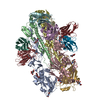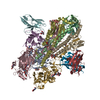+Search query
-Structure paper
| Title | Allelic polymorphism controls autoreactivity and vaccine elicitation of human broadly neutralizing antibodies against influenza virus. |
|---|---|
| Journal, issue, pages | Immunity, Vol. 55, Issue 9, Page 1693-11709.e8, Year 2022 |
| Publish date | Aug 6, 2022 |
 Authors Authors | Maya Sangesland / Alba Torrents de la Peña / Seyhan Boyoglu-Barnum / Larance Ronsard / Faez Amokrane Nait Mohamed / Thalia Bracamonte Moreno / Ralston M Barnes / Daniel Rohrer / Nils Lonberg / Musie Ghebremichael / Masaru Kanekiyo / Andrew Ward / Daniel Lingwood /  |
| PubMed Abstract | Human broadly neutralizing antibodies (bnAbs) targeting the hemagglutinin stalk of group 1 influenza A viruses (IAVs) are biased for IGHV1-69 alleles that use phenylalanine (F54) but not leucine (L54) ...Human broadly neutralizing antibodies (bnAbs) targeting the hemagglutinin stalk of group 1 influenza A viruses (IAVs) are biased for IGHV1-69 alleles that use phenylalanine (F54) but not leucine (L54) within their CDRH2 loops. Despite this, we demonstrated that both alleles encode for human IAV bnAbs that employ structurally convergent modes of contact to the same epitope. To resolve differences in lineage expandability, we compared F54 versus L54 as substrate within humanized mice, where antibodies develop with human-like CDRH3 diversity but are restricted to single V genes. While both alleles encoded for bnAb precursors, only F54 IGHV1-69 supported elicitation of heterosubtypic serum bnAbs following immunization with a stalk-only nanoparticle vaccine. L54 IGHV1-69 was unproductive, co-encoding for anergic B cells and autoreactive stalk antibodies that were cleared from B cell memory. Moreover, human stalk antibodies also demonstrated L54-dependent autoreactivity. Therefore, IGHV1-69 polymorphism, which is skewed ethnically, gates tolerance and vaccine expandability of influenza bnAbs. |
 External links External links |  Immunity / Immunity /  PubMed:35952670 / PubMed:35952670 /  PubMed Central PubMed Central |
| Methods | EM (single particle) |
| Resolution | 3.02 - 3.37 Å |
| Structure data | EMDB-25039, PDB-7scn: EMDB-25040, PDB-7sco: |
| Chemicals |  ChemComp-NAG: |
| Source |
|
 Keywords Keywords |  VIRAL PROTEIN/Immune System / VIRAL PROTEIN/Immune System /  hemagglutinin / hemagglutinin /  influenza / influenza /  antibody / antibody /  VIRAL PROTEIN / VIRAL PROTEIN /  VIRAL PROTEIN-Immune System complex / H1 VIRAL PROTEIN-Immune System complex / H1 |
 Movie
Movie Controller
Controller Structure viewers
Structure viewers About Yorodumi Papers
About Yorodumi Papers










